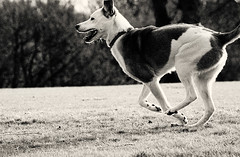I have been thinking on this for a while, after a bit of a twitter debate with friends. Two horses very sadly died this year in the Grand National, leading to a whole bunch of people to say the race is too dangerous and should immediately cease. I ought to begin by saying I don’t bet on the National (apart from office sweepstakes) and I do think that there are further things that can be done to improve the safety of the horses and jockeys (limiting the field would be a start, because 40 is a ridiculous number that is just asking for trouble), but I have and probably will continue to defend its existence as a steeplechase. I don’t want to get too hung up on the Grand National though, otherwise this will be a really boring post for most people.
The biggest risk with the National – and I promise, this has a dog-related point – is that there are always hopeless long shots entered into the race. Yes, they have a qualifying procedure, but most owners and trainers know if they’re horse can make the trip or not and will enter them regardless, because they think there’s an off chance they’ll get the opportunity to say they’ve won this race (plus the massive prize money won’t go amiss either). They’re willing to risk their horse being injured, or at worst, die, because there is a chance for glory.
But we see this same mentality in dog sports, don’t we? Ok, the risk of death is almost non-existent. Likewise, there is no financial gain (usually). But there is also no drug-testing and little regulation of lame or unsound dogs running. Thinking honestly, how many people to do you know that are normally sane, compassionate and reasoned, but have run their dog on Metacam* for a Final, or Qualifier? I can think of a dozen at least. I know a lot of flyballers who have Metacam in their cars, just in case their dog goes lame after the morning’s racing and they need a quick dose so they can flyball in the afternoon, particularly for the Champs. People get so caught up on the need to win the big events that they will sacrifice their dog’s health for that one day or weekend.
A more directly obvious comparison with the National (barring death risk and prize money extremes, and if you squint quite a lot) is Crufts. We train our dogs to the best we can, but we still all desperately try to qualify for an event that we know has an unsuitable environment for agility. We know the majority of dogs do not run well on carpet, and that the equipment has a tendency to slip (weaves, tunnels). The injury risk is much greater, the crowds/stress is much greater, but we still try and qualify for it.
Tangent: how many people will run their dogs outdoors when it’s raining? I know this horrifies plenty of the American handlers, but we do it regularly.
I wonder what level of risk is acceptable? (Why yes, often my trains of thought are sometimes tangential and weird; how did I get from the Grand National to this?) Dogs running on medication is a no, for me. I’d run Kim at Crufts again but I wouldn’t try to qualify Dylan. I’ll run in the rain but only to a certain point, if there is a torrential downpour and the contact equipment in particular looks slippery, I’ll pull my dogs (I’ll admit I don’t like running in the rain either as well, so that might have something to do with it).
I don’t really know where I’m going with this, or what my final point is. Sorry if you just wasted 10minutes reading all that.
*I’m using Metacam as my example drug of choice, but only because it seems to be the most common. Some people prefer different painkillers, some go with homeopathy options like arnica. I hope it’s obvious that whatever the drug is, is irrelevant.
**The level of risk with regards to the National will always be fluid, unfortunately, due to the fragile nature of horses. No deaths would be a good place to start, but of course horses with broken legs (usually) have to be euthanized, so do we go to no broken legs? Risk of a broken leg on flat racing is still pretty risky. Breed horses with stronger legs, but lose the speed? The risk of our hardier agility dogs getting a broken leg from agility is also somewhat risky, but of course dogs with broken legs are adaptable and can go back to what they did after recovery. I think it’s fair to say my comparison throughout this post is therefore tenuous at best, but it is what got me thinking so I included it anyway.
